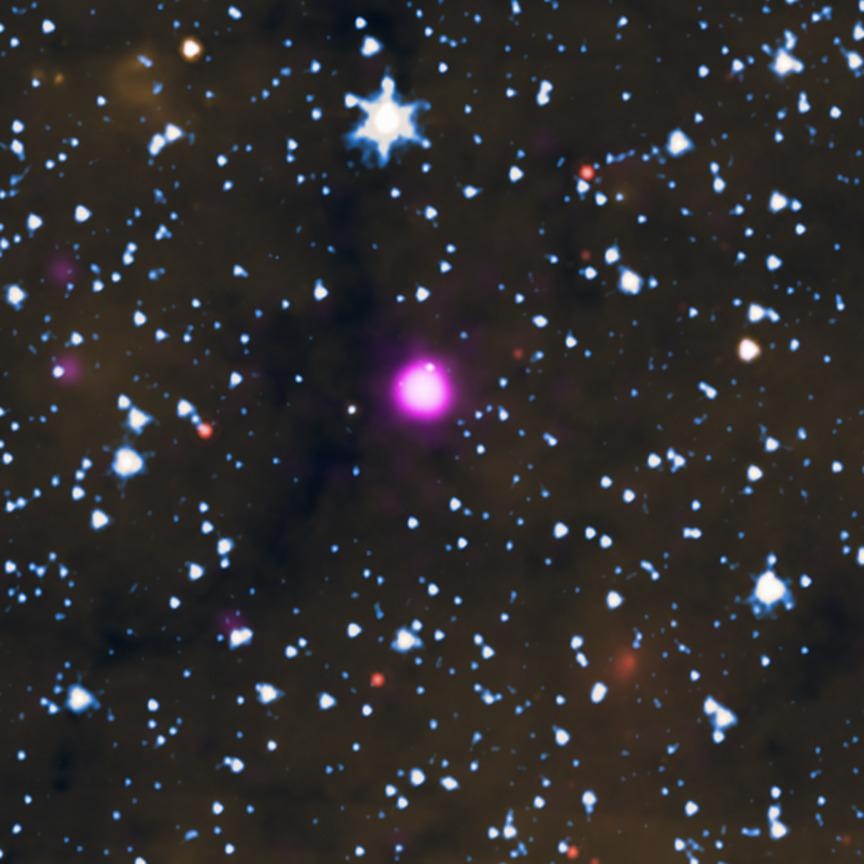Jan 11 2021
Recently in 2020, astronomers had expanded a unique family of unusual objects with the finding of a new magnetar. These latest observations made from the Chandra X-ray Observatory at NASA help support the concept that this magnetar is also a pulsar, which means it produces standard pulses of light.
 Close-Up Image of J1818.0-1607. Image Credit: X-ray—NASA/CXC/the University of West Virginia/H. Blumer; Infrared (Spitzer and Wise)—NASA/JPL-CalTech/Spitzer.
Close-Up Image of J1818.0-1607. Image Credit: X-ray—NASA/CXC/the University of West Virginia/H. Blumer; Infrared (Spitzer and Wise)—NASA/JPL-CalTech/Spitzer.
Magnetars are essentially a kind of neutron star, an extraordinarily dense object chiefly composed of closely packed neutrons, which develop from the collapsed core of a giant star at the time of a supernova.
Besides this, one aspect that makes magnetars different from other neutron stars is that they have the strongest known magnetic fields in the Universe. As such, the strength of the Earth’s magnetic field has a value of around one Gauss, whereas a refrigerator magnet has a value of around 100 Gauss.
On the other hand, magnetars have magnetic fields of around a million billion Gauss. If a magnetar was situated one-sixth of the way to the Moon (approximately 40,000 miles), it would erase the information from all the credit cards on the planet Earth.
Through NASA’s Neil Gehrels Swift Telescope, astronomers detected a novel magnetar on March 12th, 2020. This magnetar is only the 31st known object, out of the around 3000 familiar neutron stars.
Post the follow-up observations, scientists established that this object, called J1818.0-1607, was unique for other reasons as well. Firstly, the J1818.0-1607 might be the youngest magnetar known so far, with an age projected to be around 500 years old.
This estimation is based on how rapidly the rotation speed is slowing and the notion that it evolved by rotating relatively faster. Secondly, the magnetar also rotates faster when compared to any previously identified ones, spinning once around every 1.4 seconds.
The J1818.0-1607 magnetar, viewed from the Chandra X-ray Observatory and acquired in less than a month following the discovery with NASA’s Neil Gehrels Swift Telescope, provided astronomers with the first high-resolution view of this magnetar in X-rays.
Besides, the Chandra data demonstrated a point source in which the magnetar was situated, and which, in turn, is enclosed by diffuse X-ray emission, probably induced by X-rays that reflect off dust situated in its surroundings (a few of these diffuse X-ray emission may also come from winds that blow away from the neutron star).
Harsha Blumer from West Virginia University and Samar Safi-Harb from the University of Manitoba based in Canada have recently reported the outcomes from the Chandra observations of the J1818.0-1607 object in The Astrophysical Journal Letters.
The composite image includes a broad wide field of view in the infrared from a couple of NASA missions, called the Wide-Field Infrared Survey Explorer (WISE) and the Spitzer Space Telescope, taken before the discovery of the magnetar.
X-rays from the Chandra X-ray Observatory revealed the magnetar in purple. The magnetar is situated near the plane of the Milky Way galaxy at a distance of around 21,000 light-years from the planet Earth.
Other astronomers have also visualized the J1818.0-1607 magnetar with radio telescopes, like the Karl Jansky Very Large Array (VLA) from NSF, and established that it emits radio waves. This means that it also has traits that are analogous to that of a regular “rotation-powered pulsar”—a form of neutron star that emits radiation beams that are identified as repeating emission pulses as they spin and slow down.
Just five magnetars, including the latest one, have been documented to also behave similar to pulsars, representing less than 0.2% of the population of known neutron stars.
Furthermore, the Chandra observations may extend support for this general concept. Both Safi-Harb and Blumer investigated how efficiently the J1818.0-1607 object is changing energy from its reducing speed of spin into X-rays.
The duo ultimately reached a conclusion that this efficiency is lower when compared to that usually found for magnetars, and probably within the range found for other pulsars powered by rotations.
The explosion that produced a magnetar of this age has probably left behind a noticeable debris field. To look for this supernova debris, both Safi-Harb and Blumer studied the X-rays from the infrared data from the Spitzer Space Telescope, the Chandra X-ray Observatory, and the radio information from the VLA. Based on the VLA and Spitzer data, the team found potential proof of a remnant but at a comparatively large distance away from the magnetar.
To cover this distance, the magnetar should travel at rates that relatively exceed those of the fastest familiar neutron stars, even believing that it is relatively older than anticipated, which would enable more travel time.
A preprint of the Astrophysical Journal Letters article penned by Blumer and Safi-Harb explaining these outcomes is now available online.
NASA’s Marshall Space Flight Center handles the Chandra program. The Smithsonian Astrophysical Observatory’s Chandra X-ray Center manages science from Cambridge Massachusetts and flight operations from Burlington in Massachusetts.
Quick Look: Chandra Studies Extraordinary Magnetar
Video Credit: X-ray—NASA/CXC/the University of West Virginia/H. Blumer; Infrared (Spitzer and Wise)—NASA/JPL-CalTech/Spitzer.
Journal Reference:
Blumer, H & Safi-Harb, S (2020) Chandra observations of the newly discovered magnetar Swift J1818.0-1607. The Astrophysical Journal Letters. doi.org/10.3847/2041-8213/abc6a2.